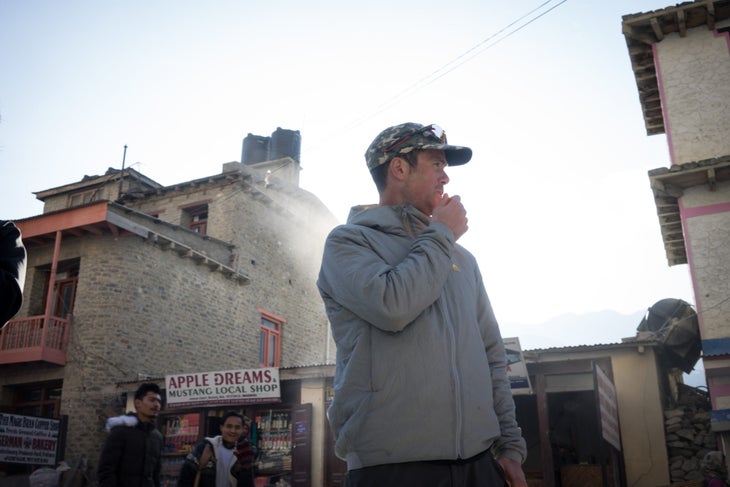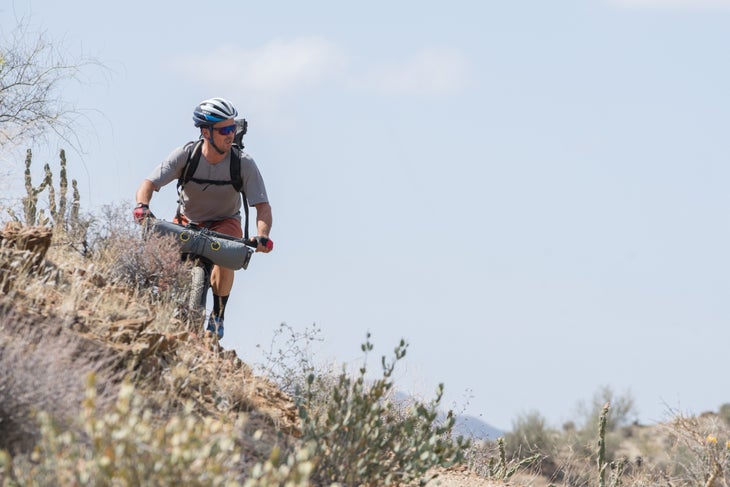Heading out the door? Read this article on the new Outside+ app available now on iOS devices for members! Download the app.
An endurance mountain biker’s mental toughness is usually honed by years of long, hard miles, and while Cory Wallace (Kona) has plenty of those, he’s also gone to what was essentially a finishing school for grit and suffering.
Up until the last few years, Wallace worked in the Canadian wilderness — as tree planter from 2003 to 2009 and as a winter lumberjack from 2011-2017. In the latter job, Wallace faced temperatures as cold as 30-below zero. He thinks those unusual vocations have helped him become a better rider, and the results seem to confirm it. Wallace won solo 24-hour world championships in 2017 and 2018. He also won the extreme high-altitude Yak Attack stage race on the Anapurna circuit in Nepal in those years.
We caught up with Wallace in Prescott, Arizona at the Whiskey Off-Road to hear a few stories from his many adventures on bikes and in the Canadian backcountry. Although a crash and a flat tire saw him finish well behind in the Epic Rides Series opener, he was 12th in 2018 — an impressive result in a stacked field.
VeloNews: It’s fair to say you have one of the most diverse backgrounds of any pro racer here. Can you give us the greatest hits?
Corey Wallace: The first adventure was a bike-touring trip down in South America. I’d taken a couple years off to play hockey and I wanted to get back into bike racing. So I wanted to build a big base and I went down to the south tip of Chile and planned on biking up to Mexico. I made it two months and then I ran out of time. I made it up to Lima, Peru. Just had my Bob trailer and camping gear. No real plan, just point A to point B.
Once I got back into racing I went to the Mongolia Bike challenge a couple of times. I enjoy that type of adventure. Tough racing, but in the middle of nowhere, diverse culture. We’d set up camp every night and the Mongolians would come in and check us out just to see what we’re doing. They’d come in with a goat and butcher the goat in front of us and barbeque it. We’d give them our bikes to ride around. It was cool to see the two cultures meet. We couldn’t speak but we could still associate with each other. Lately, it’s been Asia — India, Bhutan, Nepal, East Timor. All those countries are just getting into racing. It’s fun to see the growth of it, every year it’s getting bigger. I’ve been to some really adventurous races there. It’s kind of a race there, but really it’s just fend for yourself. It’s kept me entertained all these years. I think if it was just cross-country racing I would have retired probably six, seven years ago. Just finding these new adventures these new races, it makes it fun.
VN: So you were playing hockey professionally?
CW: I played hockey up to a junior level. That was my dream to be an NHL player. I was a bit too small. I had good skills but I always got wailed on by the bigger guys. So when I was 21 I gave up on that dream and shifted back to bike racing.
VN: So the hockey thing didn’t work out, but you got the bug for adventurous bike events. Was it hard to learn the craft of those types of events or trips, the preparation?
CW: Yeah the first trip to South America I was so unprepared. I had a Bob trailer with so much crap in it. I could barely pull it with my bike. Every trip I’ve gotten lighter and lighter. That trip I had no clue what I was doing, I was just like, ‘Hey let’s bike from here to there, 5,000k or whatever it is.’ Bike racing, I did a bunch of it when I was growing up during the off-season from hockey. I knew what bike racing was. But XC wasn’t my skill set, it was the longer events. So I talked to Kona to ask if they had a marathon spot. That was when marathon was taking off. I went down to La Ruta in Costa Rica. I did that three years in a row. Back then it was a real adventure coast to coast four days. I noticed that I excelled in that type of racing, the crazier it got, the better I did. I hit up a couple 24-hour races. That suited me as well. I think that goes back to tree planting. I used to be a tree planter. You put hip bags on, 4 or 500 trees, you go walk around the clear-cut for a couple hours unloading the bags. We’d plant like 2 or 3,000 trees a day you’re talking 10-, 12-hour days, just going like this … [Wallace pantomimes walking one step, bending over to plant a tree, taking another step, bending over again, and on, and on.]
The first two weeks you just want to quit and go home, but your mind adapts to it and you just accept that life kind of sucks. So I did that for a couple months, and I think that built the mental ability to ride 24 hours. I had some success with that, was welcomed to the Kona team, and since then it’s blossomed. It’s been cool with Barry doing the Kona Adventure Team projects.

VN: You actually won solo 24-hour world championships in the last two years.
CW: That was my cycling goal because the first one I did was worlds in Canmore [Alberta] in like 2000. I was sitting top-20 and this crazy storm came in the middle of the night. It made the trails super muddy and soupy. There was a bunch of Australians in it that year and they just pulled the pin. And I just kept going, whatever. And then in the morning they were saying ‘you’re top-10,’ then top-eight, top-seven. I ended up fifth that one, but I realized how many times I messed up. I had the equivalent of 85 cups of coffee. It was just caffeine overload. I was doing 1,000mg vitamin C packs in every water bottle. So it was like 20,000mg of vitamin C. My body, I had to get rid of it, so I had to piss every 25 minutes. I just did so many mistakes and I said, I could win this one someday, it took me eight years to finally win it. In Australia, I dislocated my shoulder, in the States, my vision went. New Zealand, I lost by two or three minutes. And then finally in Italy in 2017, it just came together and I had the perfect race. And last year in Scotland I had an even better race. The weather helped me out there. It got pretty nasty in the middle of the night, took out a few guys. Yeah, back-to-back was pretty cool. That was my long-term goal. It was cool we got that.
VN: Do you think about that tree-planting job in those races at all?
CW: Yeah. Tree planting … you’re planting in a snowstorm sometimes, really shitty weather. I remember one time we were planting on a coastal island, a helicopter flew in, dropped us off, and it was raining and it turned to snow. The helicopter was gone for 10 hours. We were so cold, soaked to the bone, it was freezing. We decided to empty the trees boxes and burn the cardboard one piece at a time. We just sat there burning boxes all day, just trying to survive.
VN: And you’ve also had a job as a lumberjack right?
CW: So tree planting was May and June, prime bike riding season. It didn’t work out well for the racing. So I quit that and started chainsawing up in the oil fields, seismic lines. The bulldozer comes in a makes a mess. We have to come in and cut down any trees they missed. We have to go in with GPS and map it out for oil exploration. That job starts as soon as the ground is frozen, usually mid-November and goes on through Feburary, March. It’s a lot physically easier than the tree planting but the weather is really cold. Up north it’s often minus 35 sometimes minus 40 [celcius], but then you don’t work. That’s the toughest part of the job, just out in the cold, layering clothes, your hands. You have to wear gloves and still use a chainsaw.
Working up there it’s good for my mentality, a good mental break. Just all the rednecks, guys that just hate bikers. A lot of those guys don’t enjoy their life, they’re just making good money. So to see the biking culture this weekend, compared to that, is the opposite end of the spectrum.
The last two winters I’ve been in Nepal and I’ve stayed the whole winter so I’ve missed it, but up until then.

VN: Right, for the Yak Attack. What is that race like?
CW: The Yak Attack race does the Anapurna Circuit in Nepal, sometimes a little bit extra. It starts at 800 meters, goes up to a pass at 5,400, so 17,000 feet. It’s just a real adventure. You’re racing on the Anapurna trekking trail and it’s prime trekking season, you’ve got hikers everywhere, you’ve got donkeys hauling supplies up the mountain. It’s just insane. You stay at teahouses every night. It’s more of a battle with the elements. Some pretty fit Europeans have gone to that one. You get to the camp and there’s no heating, no nothing, and they find that pretty tough.
The highlight of that race is the descent off the 17,000-foot pass. It’s like a 45-minute descent on singletrack all the way down to 8,000 feet. It’s insane it takes hikers like eight hours. It takes bikers like 45 minutes. The trail goes everywhere. It’s a free-for-all. There’s probably 10 ways down the mountain. The Nepalis know all the right lines so I’ll see them on the other side of the mountain going down, so I’ll cross over to there. And then the altitude. Most of that race is up at 12,000 plus.
VN: It’s quite a contrast between that and a race like the Whiskey Off-Road. How is it to go between those extremes?
CW: It’s a bit of a shock for sure, but that’s what keeps me going is the extremes of it. The chaos in Nepal and India is fun for a while but it sometimes gets old. It’s nice to come to Whiskey 50 and know what we’re doing. There’s not too many X-factors here. It’s who’s the fittest, who can ride this trail fast.
This interview was edited for length and clarity.